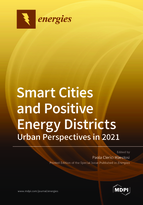Smart Cities and Positive Energy Districts: Urban Perspectives in 2021
A special issue of Energies (ISSN 1996-1073). This special issue belongs to the section "G: Energy and Buildings".
Deadline for manuscript submissions: closed (31 July 2021) | Viewed by 29112
Special Issue Editor
Interests: BIM; sustainable development; sustainability; urban development; urban planning; urban sustainability; renewable energy technologies; land use planning; architecture; sustainable architecture
Special Issues, Collections and Topics in MDPI journals
Special Issue Information
Dear Colleagues,
Since 2018, the EERA Joint Programme on Smart Cities has promoted and published the most promising papers on tools, technologies, and system integration for Smart Cities and Positive Energy Districts, thus, positioning the EERA Joint Programme on Smart Cities as one of the strongest voices in this research area in Europe, capable of highlighting different points of view and solutions.
According to this, our ambition for the coming 4th Special Issue is to collect and publish original works, in the form of applied research and case studies (national/international RD&I projects; real solutions at national level implemented/in operation stage or implementation stage or planning stage), on the following:
- Tools, technologies and system integration for smart cities
- Tools, technologies and system integration for positive energy districts
Dr. Paola Clerici Maestosi
Guest Editor
Manuscript Submission Information
Manuscripts should be submitted online at www.mdpi.com by registering and logging in to this website. Once you are registered, click here to go to the submission form. Manuscripts can be submitted until the deadline. All submissions that pass pre-check are peer-reviewed. Accepted papers will be published continuously in the journal (as soon as accepted) and will be listed together on the special issue website. Research articles, review articles as well as short communications are invited. For planned papers, a title and short abstract (about 100 words) can be sent to the Editorial Office for announcement on this website.
Submitted manuscripts should not have been published previously, nor be under consideration for publication elsewhere (except conference proceedings papers). All manuscripts are thoroughly refereed through a single-blind peer-review process. A guide for authors and other relevant information for submission of manuscripts is available on the Instructions for Authors page. Energies is an international peer-reviewed open access semimonthly journal published by MDPI.
Please visit the Instructions for Authors page before submitting a manuscript. The Article Processing Charge (APC) for publication in this open access journal is 2600 CHF (Swiss Francs). Submitted papers should be well formatted and use good English. Authors may use MDPI's English editing service prior to publication or during author revisions.
Keywords
- sustainable urban areas
- energy production
- energy efficiency
- energy flexibility






